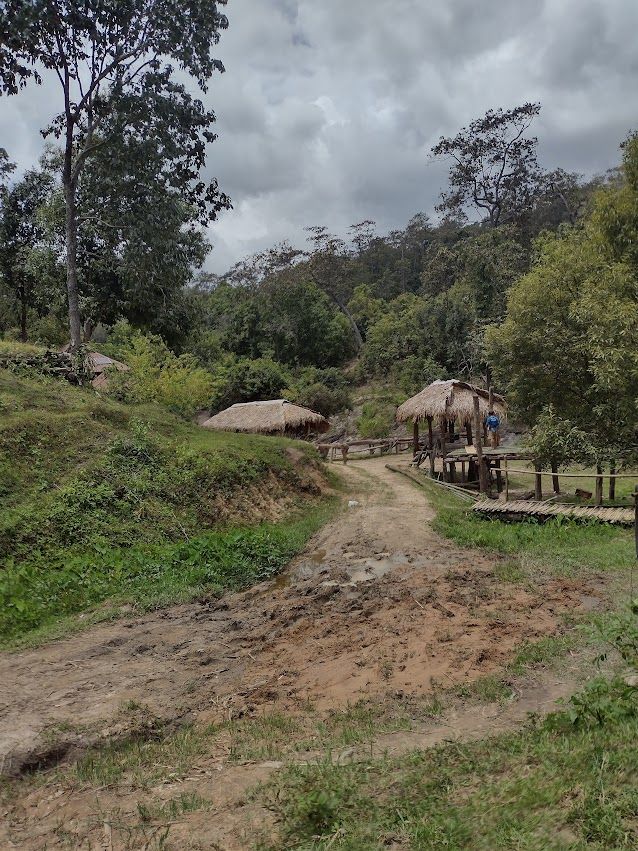
A day in a tiny Karen village, a visit to a family might help you understand far better how elephants are integrated into daily life
Dear Reader: This is the third in a series of articles I'm writing on elephant experiences and "sanctuaries" particularly in the Chiang Mai area of Thailand. There are far too many, all of which claim much the same thing ("ethical" treatment) and many if not most either refuse or avoid any kind of formal audits by internationally-recognized bodies. Most operators can be quite poor. An audit which demands upgrades will be devastating, so it's understandable, but damaging to the elephants' welfare as well as the education of the average tourist. This is my attempt to offer some perspective and guidance as to how to make an informed decision.
First, can I please clarify this term? Sanctuary means something very specific to an English-speaker:
- A place of refuge or safety
- A nature reserve
One of the problems we as tourists run into is that how we understand this term may not be how it's understood here in Thailand. Perhaps more importantly, because the term sells tickets to tourists who honestly and sincerely think that their money is going to saving elephants, the term has lost all agency here. You have to visit plenty of places, understand the elephant tourist business a lot better (I am still a novice) to really embrace how loosely-interpreted "sanctuary" really is.
If the elephants really are "retired" and really are living on a "sanctuary," they would not be subjected to tons and tons of tourists interrupting their daily meals and demanding play time. Even if play time is fun for them, elephants in their normal lives don't seek out thousands of tourists. Not even. That's the whole point of refuge, kindly, to get away from us.
This is why nature purists argue to leave them alone. That unfortunately isn't feasible for the two reasons I keep repeating: there isn't enough wild, and what is wild is a hotbed for poachers, which goes for tigers and anything else our greed wants to consume. And finally, domesticated elephants wouldn't survive in the wild as they haven't been taught how to forage by wild mama and matriarchs. This is humans' doing and ultimately ours to clean up.
Because I wish to acknowledge the views of folks who have done serious research into the inherent abuses into the elephant industry, please see this article by PETA (People for the Ethical Treatment of Animals):

Truth? I agree with much if not most of what they say. Fact is that real life shoves ethics aside. As we will see, tourism in this industry is for some people, their only option. War, population growth, ugly immigration policies and politics all force some of the practices that PETA discusses. That said, I am doing my best to offer perspective and some suggestions for how to visit these remarkable animals in Thailand.
This article touches on my third excursion, this time into the high country near Chiang Mai.
The Karen people
The term describes an ethnic minority. The pronunciation is Ka-reen, emphasis on the second syllable. This detailed piece will give you a better understanding of this particular group:

My taxi driver at the Chiang Mai airport, Mr. Sompop or Sam, told me about an elephant activity that he was partnered with which involved the Karen people. Sam has spent time as a monk, which is quite common in this part of the world, and like most Thai men, he has also had military experience. What struck me about Sam was how quiet, deliberate and caring he was, so his recommendation landed on fertile ground.
He called his partner, Mr. Joe, and they arranged for me to join another group of women which was heading up to a Karen village in the big national park close to Chiang Mai:
https://www.thainationalparks.com/doi-inthanon-national-park.
To be fair, the brochure for Mr. Joe's outfit is not much different from any other colorful offering, the likes of which are jammed and crammed into every nook and cranny in downtown Chiang Mai's hotel areas. All of them clamor for your attention and they all make identical claims. Most aren't terribly accurate. Some are patently dishonest, so the traveler is left to stumble through those offerings. Mr. Joe's brochure makes no mention at all of the longer trips where you can stay overnight, for example, and learn to cook. Nor does the Facebook page.
Most of us, new to Thailand and eager for experiences, do our best to choose wisely. The plight of both people and elephant in this part of the world is considerable and exacerbated by Covid and a government which imposes laws upon but doesn't offer alternatives to its people. Joe and Sam's outfit is trying to provide income for some Karen villagers while also educating tourists about their lifestyle.
Sam picked me up at 8:30 for our trip, which included three young European women who were heading up to the higher Karen villages and spending a few days with the locals. They would learn how to cook and get a full immersion experience.
Sam brought us to the lower village restaurant for a quick lunch of mostly rice and a few bits of vegetable. There, the three girls were hauled into the high forest. Sam, Joe and I took off on the winding high road to the small community, nestled next to a river in the high country.
The northern part of Thailand shares a border with Myanmar. Ethnic hill tribes are regularly harassed and brutalized by the military regime, causing millions to be displaced. You may well be familiar with the genocide of the Rohingya people, but be assured: Myanmar -including some of its Buddhist monks- is brutal to all the hill tribes when it comes to ethnic cleansing. Thailand isn't particularly welcoming, either, forcing those fleeing death to make difficult choices for their survival.
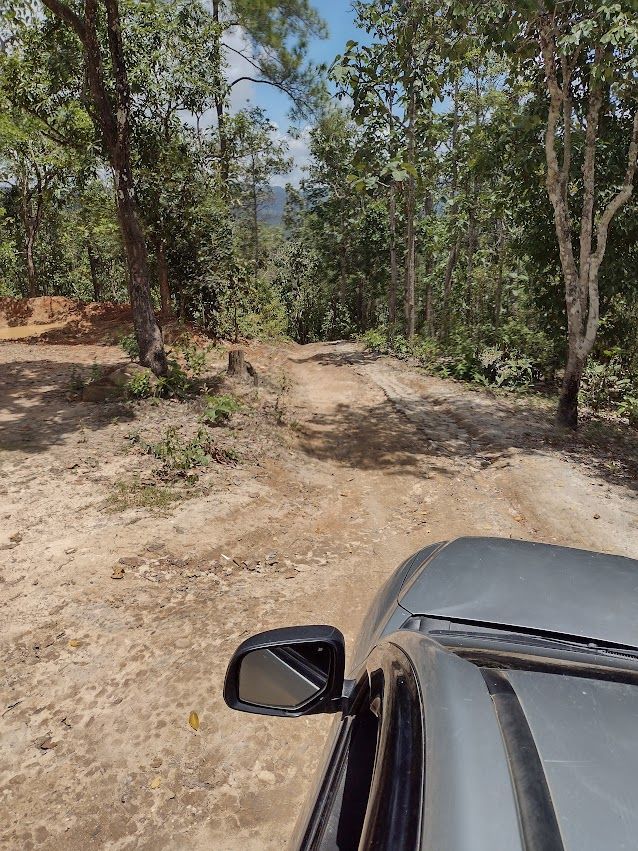
I've visited a number of tribes in the high country, including in Myanmar. These people are living precarious lives, often cut off from resources such as medical care. Here at least the people I saw had land, elephants and each other.
Elephants are family members
We drove a steep road which had only recently been completed, the construction of which was invariably delayed by heavy rains. We reached a point where the son of one of the families met us and we left our truck behind. Then we headed down the clay road into a smallish valley, where the thatched roofs were visible, dotting the landscape next to a tumbling, rocky stream.
Two females and a rambunctious youngster were partially enclosed; the little girl headed to cause us regular havoc while we spoke. In our eagerness to be around these great creatures we forget that first, this isn't Disney World (and I've worked there), the animals are NOT trained for our pleasure, and it is our job to be mindful of where they are and above all, how incredibly huge and heavy they are.
Your body is a toothpick to them.
That said, Joe and I sat on the picnic table while the baby ran circles around us, tried to steal my backpack and insisted on shoving everyone around. He provided me with additional history and context.
The Karen people build their own huts here. They are elevated, which creates a wooden porch so that air can flow underneath the house. That works to keep things relatively cool. That said in this part of northern Thailand it can get to freezing in winter.
One of the young men in the family was dressed in camouflage, an unfortunate reminder that the Karen people are forever at war with someone who is bent on burning their villages and fields. I spent time in the water with him and the family matriarch, and solidly nailed him with a pan of water intended for mama.
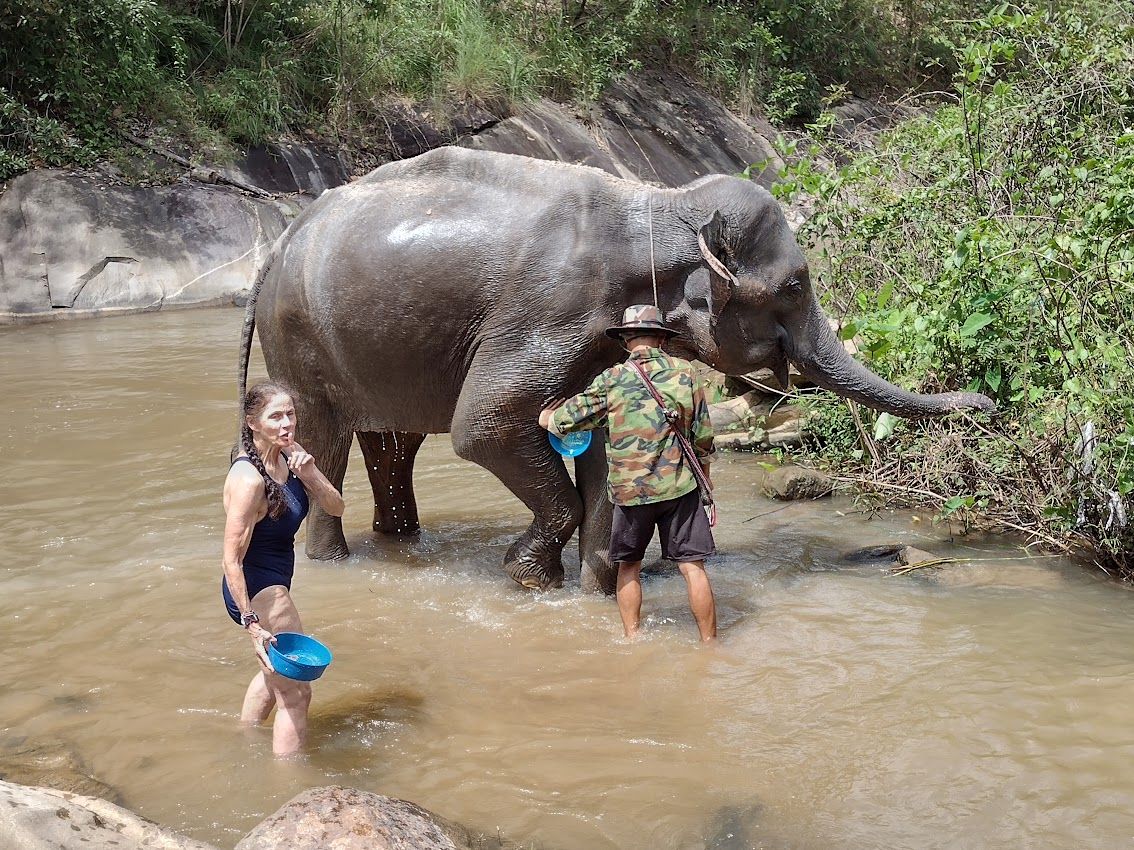
The villagers were building a bamboo observation platform so that more tourists can engage with the elephants safely. I get the importance of this but the fundamental problem is that the more people who come, the more impact on this village and the elephants. This is the problem with human need and growth all over the world.
On one hand, the income is badly needed. On the other, the very idea of "refuge" is lost in translation. There is no such thing as a sanctuary or a refuge when we are trucking thousands of tourists in to interact with animals who are likely happier without such demands on them, which is to PETA's point.
Still, that said, the long ride and the isolation offer a more engaged traveler a chance to see part of Thailand that is out of the way, visit the Karen people in their own world and see how much the elephants are integrated into the family.
Is this ideal? Of course not. Would I prefer the elephants live in their own herds unaffected by us? Of course I would. As I have written before, ideally we leave the wild to the wild, we protect the forests, leave the ellies alone and stop the poachers. I would love for that to be a realistic option.
However with too many people living in abject poverty, a government unable or unwilling to do much about them (just like in the USA and elsewhere), people are left to do what they can with what they have.
This is in no way a criticism of Mr. Joe and Sam. I value what they're doing more than most of the rest of the facilities which make patently false claims. Here at least they are making an effort to benefit people who have been dealt a lousy hand by fate and fanatics.
Of my visits, this one appealed a lot because it entailed a commitment on our part to spend more time and learn about the villagers, not just to go and gawk. Staring at ethnic minority villagers is a thing, particularly for the people of the Long Neck tribes, another ethnic minority actively oppressed by the Myanmar military.
While this isn't about elephants, this read gives you a pretty good idea of the the challenges these tribes face in Thailand, and why tourism became the primary option for survival:

Many of the points in the article apply equally to elephant visits. While purists argue never to go at all, not going is even more impactful to these people.
You can see how challenging this is, and why I am doing my best to straddle the line between spending your tourist dollar as ethically as possible and reducing the invasiveness of constant tourism on people and animals. It's damned hard, because everyone has a stake in the outcome. The more desperate people are the more likely animal abuses are to be widespread.
The more I dig into these issues, the more complex they become. A part of me feels guilty for wanting to engage with elephants, and another part of me knows that those dollars, at least in some cases, can go a long way if I choose carefully.
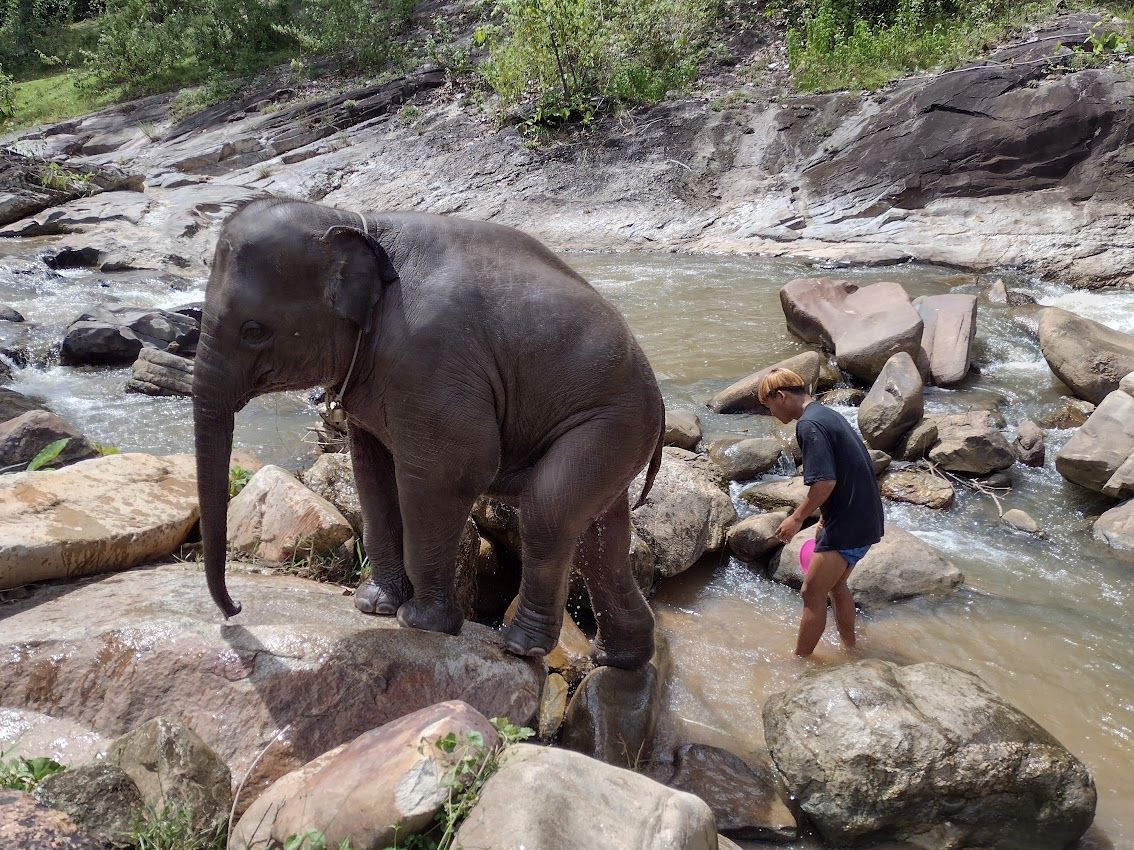
Ultimately this is up to you. If it's too much of a moral dilemma, don't go. Visit the temples, donate to PETA or similar organizations. However if you do visit elephants here, please take the time to investigate.
There are no easy answers where wildlife is concerned, for we have wiped out so much of the wild that we are fast-tracking to a time where the only ellies or tigers or pangolins we see will be in captivity.
I have one more facility to visit down near Phuket. Stay tuned. I hope to offer good news.
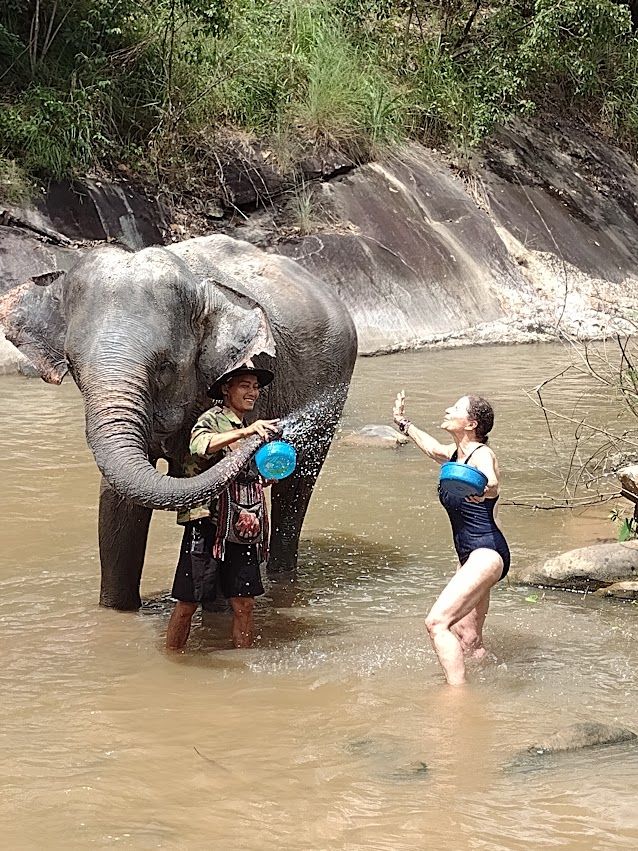
Dear Walkabout Saga Reader:
If my work appeals to you, may I kindly invite you to consider joining those Patreon supporters whose generosity keeps the gas in my tank as it were. Those supporters get to dictate my content calendar, we engage as a community, and this website and its content acts in service to our collective best selves.
You can explore that option here.
However you decide to partake of my writing, thank you.



Comments powered by Talkyard.